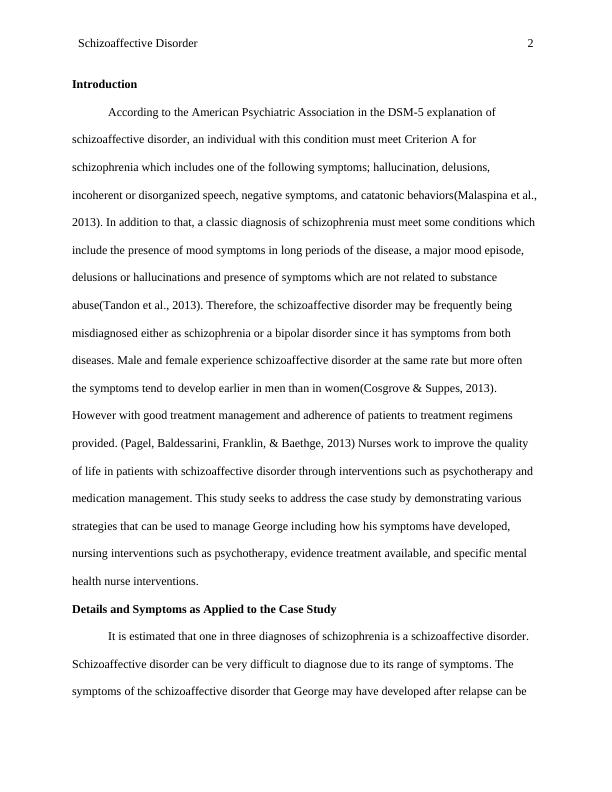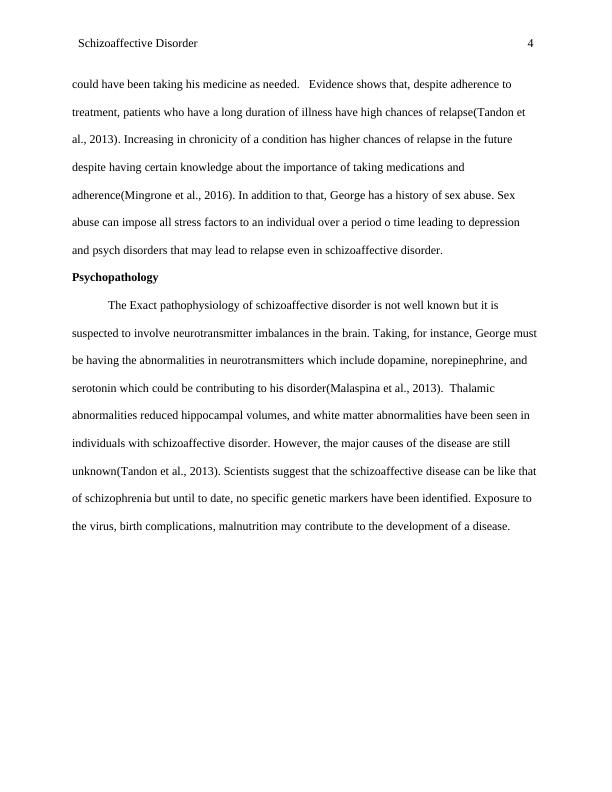Schizoaffective Disorder Case Study
Added on 2023-01-19
12 Pages3126 Words29 Views
Running head: Schizoaffective Disorder 1
Schizoaffective Disorder Case Study
(Author’s name)
(Institutional Affiliation)
Schizoaffective Disorder Case Study
(Author’s name)
(Institutional Affiliation)

Schizoaffective Disorder 2
Introduction
According to the American Psychiatric Association in the DSM-5 explanation of
schizoaffective disorder, an individual with this condition must meet Criterion A for
schizophrenia which includes one of the following symptoms; hallucination, delusions,
incoherent or disorganized speech, negative symptoms, and catatonic behaviors(Malaspina et al.,
2013). In addition to that, a classic diagnosis of schizophrenia must meet some conditions which
include the presence of mood symptoms in long periods of the disease, a major mood episode,
delusions or hallucinations and presence of symptoms which are not related to substance
abuse(Tandon et al., 2013). Therefore, the schizoaffective disorder may be frequently being
misdiagnosed either as schizophrenia or a bipolar disorder since it has symptoms from both
diseases. Male and female experience schizoaffective disorder at the same rate but more often
the symptoms tend to develop earlier in men than in women(Cosgrove & Suppes, 2013).
However with good treatment management and adherence of patients to treatment regimens
provided. (Pagel, Baldessarini, Franklin, & Baethge, 2013) Nurses work to improve the quality
of life in patients with schizoaffective disorder through interventions such as psychotherapy and
medication management. This study seeks to address the case study by demonstrating various
strategies that can be used to manage George including how his symptoms have developed,
nursing interventions such as psychotherapy, evidence treatment available, and specific mental
health nurse interventions.
Details and Symptoms as Applied to the Case Study
It is estimated that one in three diagnoses of schizophrenia is a schizoaffective disorder.
Schizoaffective disorder can be very difficult to diagnose due to its range of symptoms. The
symptoms of the schizoaffective disorder that George may have developed after relapse can be
Introduction
According to the American Psychiatric Association in the DSM-5 explanation of
schizoaffective disorder, an individual with this condition must meet Criterion A for
schizophrenia which includes one of the following symptoms; hallucination, delusions,
incoherent or disorganized speech, negative symptoms, and catatonic behaviors(Malaspina et al.,
2013). In addition to that, a classic diagnosis of schizophrenia must meet some conditions which
include the presence of mood symptoms in long periods of the disease, a major mood episode,
delusions or hallucinations and presence of symptoms which are not related to substance
abuse(Tandon et al., 2013). Therefore, the schizoaffective disorder may be frequently being
misdiagnosed either as schizophrenia or a bipolar disorder since it has symptoms from both
diseases. Male and female experience schizoaffective disorder at the same rate but more often
the symptoms tend to develop earlier in men than in women(Cosgrove & Suppes, 2013).
However with good treatment management and adherence of patients to treatment regimens
provided. (Pagel, Baldessarini, Franklin, & Baethge, 2013) Nurses work to improve the quality
of life in patients with schizoaffective disorder through interventions such as psychotherapy and
medication management. This study seeks to address the case study by demonstrating various
strategies that can be used to manage George including how his symptoms have developed,
nursing interventions such as psychotherapy, evidence treatment available, and specific mental
health nurse interventions.
Details and Symptoms as Applied to the Case Study
It is estimated that one in three diagnoses of schizophrenia is a schizoaffective disorder.
Schizoaffective disorder can be very difficult to diagnose due to its range of symptoms. The
symptoms of the schizoaffective disorder that George may have developed after relapse can be

Schizoaffective Disorder 3
categorized into three major groups which include manic symptoms, psychotic symptoms and
depressive symptoms(Jung & Newton, 2009). Some of the psychotic symptoms that he may have
developed include losing touch with reality, chaotic and disorganized speech, delusions,
hallucinations, apathy, anxiety, inability to move and black facial expression(Zeng et al., 2015).
Manic symptoms may include rapid thought and speech, increase sexual activity, risky
behaviors, exaggerated self-esteem, impulsive behaviors reduce the need for sleep, increase
sexual and work activity, and changes in mood between anger to happiness. Depressive
symptoms include concentration difficulties, loss of interest and motivation, fatigue, insomnia,
suicidal thoughts, and low self-esteem(Malaspina et al., 2013). George is said to be
schizoaffective since he must have developed one or more symptom in each of the above
categories. Schizoaffective patients usually have one or two of both bipolar and schizophrenia
symptoms.
Relapse occurs when a patient who has been doing well start to worsen for a given period
of time(Mingrone et al., 2016). Most of the early signs of relapse include the above-mentioned
symptoms which often lead to hospitalization just like in George case. George has been living at
home, meaning he has been doing well. From the case, George seems to have been working but
now currently he is not. In most cases, relapse symptoms are brought up by patient failing to take
medicine due to some reasons such as a feeling of wellness, lack of insight, lack of enough
knowledge why it is of importance to take medicine and poor family support. Since George was
properly working, he could have been having a feeling of wellness and maybe stop taking the
medicines(Goff, Hill, & Freudenreich, 2010). His brother has been supportive of him meaning he
has enough family support. However, in schizoaffective disorder, relapse can occur even if the
patient is taking the medicine properly. George, with enough support from his brother, seems he
categorized into three major groups which include manic symptoms, psychotic symptoms and
depressive symptoms(Jung & Newton, 2009). Some of the psychotic symptoms that he may have
developed include losing touch with reality, chaotic and disorganized speech, delusions,
hallucinations, apathy, anxiety, inability to move and black facial expression(Zeng et al., 2015).
Manic symptoms may include rapid thought and speech, increase sexual activity, risky
behaviors, exaggerated self-esteem, impulsive behaviors reduce the need for sleep, increase
sexual and work activity, and changes in mood between anger to happiness. Depressive
symptoms include concentration difficulties, loss of interest and motivation, fatigue, insomnia,
suicidal thoughts, and low self-esteem(Malaspina et al., 2013). George is said to be
schizoaffective since he must have developed one or more symptom in each of the above
categories. Schizoaffective patients usually have one or two of both bipolar and schizophrenia
symptoms.
Relapse occurs when a patient who has been doing well start to worsen for a given period
of time(Mingrone et al., 2016). Most of the early signs of relapse include the above-mentioned
symptoms which often lead to hospitalization just like in George case. George has been living at
home, meaning he has been doing well. From the case, George seems to have been working but
now currently he is not. In most cases, relapse symptoms are brought up by patient failing to take
medicine due to some reasons such as a feeling of wellness, lack of insight, lack of enough
knowledge why it is of importance to take medicine and poor family support. Since George was
properly working, he could have been having a feeling of wellness and maybe stop taking the
medicines(Goff, Hill, & Freudenreich, 2010). His brother has been supportive of him meaning he
has enough family support. However, in schizoaffective disorder, relapse can occur even if the
patient is taking the medicine properly. George, with enough support from his brother, seems he

Schizoaffective Disorder 4
could have been taking his medicine as needed. Evidence shows that, despite adherence to
treatment, patients who have a long duration of illness have high chances of relapse(Tandon et
al., 2013). Increasing in chronicity of a condition has higher chances of relapse in the future
despite having certain knowledge about the importance of taking medications and
adherence(Mingrone et al., 2016). In addition to that, George has a history of sex abuse. Sex
abuse can impose all stress factors to an individual over a period o time leading to depression
and psych disorders that may lead to relapse even in schizoaffective disorder.
Psychopathology
The Exact pathophysiology of schizoaffective disorder is not well known but it is
suspected to involve neurotransmitter imbalances in the brain. Taking, for instance, George must
be having the abnormalities in neurotransmitters which include dopamine, norepinephrine, and
serotonin which could be contributing to his disorder(Malaspina et al., 2013). Thalamic
abnormalities reduced hippocampal volumes, and white matter abnormalities have been seen in
individuals with schizoaffective disorder. However, the major causes of the disease are still
unknown(Tandon et al., 2013). Scientists suggest that the schizoaffective disease can be like that
of schizophrenia but until to date, no specific genetic markers have been identified. Exposure to
the virus, birth complications, malnutrition may contribute to the development of a disease.
could have been taking his medicine as needed. Evidence shows that, despite adherence to
treatment, patients who have a long duration of illness have high chances of relapse(Tandon et
al., 2013). Increasing in chronicity of a condition has higher chances of relapse in the future
despite having certain knowledge about the importance of taking medications and
adherence(Mingrone et al., 2016). In addition to that, George has a history of sex abuse. Sex
abuse can impose all stress factors to an individual over a period o time leading to depression
and psych disorders that may lead to relapse even in schizoaffective disorder.
Psychopathology
The Exact pathophysiology of schizoaffective disorder is not well known but it is
suspected to involve neurotransmitter imbalances in the brain. Taking, for instance, George must
be having the abnormalities in neurotransmitters which include dopamine, norepinephrine, and
serotonin which could be contributing to his disorder(Malaspina et al., 2013). Thalamic
abnormalities reduced hippocampal volumes, and white matter abnormalities have been seen in
individuals with schizoaffective disorder. However, the major causes of the disease are still
unknown(Tandon et al., 2013). Scientists suggest that the schizoaffective disease can be like that
of schizophrenia but until to date, no specific genetic markers have been identified. Exposure to
the virus, birth complications, malnutrition may contribute to the development of a disease.

End of preview
Want to access all the pages? Upload your documents or become a member.
Related Documents
Nursing Plan of Care for Schizoaffective Disorder: A Case Studylg...
|11
|2995
|42
Signs and symptoms of schizophrenia Report 2022lg...
|5
|996
|21
Essay on Schizoaffective disorderlg...
|13
|3401
|196
Schizoaffective Disorder Schizophrenialg...
|13
|4531
|28
NRS2342 Mental Health Nursinglg...
|7
|2179
|53
Mental Health: Understanding Paranoid Schizophrenia and Treatmentlg...
|7
|1805
|69
